Future-Proofing Infrastructure in the Lake Victoria Basin Through Climate Planning
The World Bank's AFRI-RES initiative is helping Lake Victoria Basin countries integrate climate risk into infrastructure planning by building institutional capacity, using advanced climate data, and fostering regional cooperation. This upstream technical assistance aims to safeguard future investments against worsening climate impacts while unlocking access to climate finance.

In a bold move to fortify climate adaptation and infrastructure resilience across East Africa, the World Bank has launched a strategic technical assistance initiative under the Africa Climate Resilient Investment Facility (AFRI-RES), focusing on the Lake Victoria Basin (LVB) countries, Burundi, Kenya, Rwanda, Tanzania, and Uganda. This ambitious program, titled the “Partnership for Climate Resilience in the Lake Victoria Basin,” brings together influential research and regional institutions such as the Lake Victoria Basin Commission (LVBC), the Inter-University Council for East Africa (IUCEA), and the East African Science and Technology Commission (EASTECO). These partners are working in close coordination with national ministries and planning authorities to mainstream climate resilience into infrastructure planning. With financing support from the Nordic Development Fund (NDF), the project seeks to address one of the region’s most pressing development challenges: how to build infrastructure that can withstand intensifying climate shocks.
Climate Shocks Threaten a Fragile Basin
The Lake Victoria Basin, Africa’s largest freshwater lake and the economic lifeblood for over 45 million people, is already reeling from the effects of climate change. The region has seen a sharp rise in floods, landslides, droughts, and extreme weather events. Rainfall patterns have become erratic, with severe consequences for agriculture, water resources, transport systems, and energy infrastructure. Despite recent infrastructure investment booms in many LVB countries, much of this infrastructure remains exposed to climate risks. This is largely due to a gap in planning processes that fail to account for long-term climate vulnerabilities. The World Bank’s intervention aims to close this gap by embedding climate risk analysis, modeling, and adaptive design practices into the planning and implementation of critical infrastructure projects. The goal is to future-proof public assets and avoid potentially massive economic and human losses over time.
A New Model: Climate-Smart Planning at the Core
What sets this initiative apart is its emphasis on upstream action. Rather than financing physical infrastructure directly, the project focuses on enhancing the capacity of institutions and individuals involved in infrastructure planning and investment decision-making. The centerpiece of this approach is the deployment of climate risk screening tools tailored to vital sectors such as transport, energy, and water management. These tools will be accompanied by regionally relevant climate data and downscaled impact models, allowing decision-makers to visualize how different assets might be affected by future climate scenarios. Training workshops, online modules, and technical support will be rolled out across all five countries to ensure that ministries, planning commissions, and infrastructure agencies are equipped with the necessary skills and systems. A particular emphasis is placed on harmonizing standards and building regional cooperation around climate data generation, analysis, and use.
Bridging Knowledge Gaps and Unlocking Finance
The AFRI-RES program’s long-term vision extends beyond technical support. By helping countries demonstrate that their infrastructure projects are climate-resilient, the initiative positions them to better access international climate finance, including green bonds and adaptation-focused funding mechanisms. A significant part of the project’s funding will go toward vulnerability assessments of critical infrastructure corridors, the development of climate-resilient engineering standards, and the integration of climate metrics into national public investment systems. The Lake Victoria Basin Commission is expected to play a lead coordination role, facilitating knowledge exchange and ensuring regional alignment. Meanwhile, academic and research institutions will help develop new curricula and certification programs to ensure a continuous pipeline of climate-competent professionals. In this way, the initiative not only boosts institutional capacity but also embeds climate resilience into the DNA of East Africa’s infrastructure ecosystem.
Building a Resilient Future Through Regional Unity
At its heart, the Partnership for Climate Resilience in the Lake Victoria Basin reflects a new ethos in African development thinking, one that sees data, foresight, and cooperation as central pillars of progress. By treating infrastructure not as isolated national assets but as part of an interconnected regional system, the project strengthens the very foundation of the East African Community’s integration efforts. Over time, improved coordination between countries and institutions is expected to foster innovation in climate science, catalyze more effective investments, and enhance public trust in the ability of governments to deliver durable and inclusive infrastructure. The project’s impact could resonate far beyond the basin, offering a scalable model for other climate-vulnerable regions across the continent.
The World Bank-led initiative arrives at a pivotal moment for East Africa. As climate threats grow more acute, the region’s ability to plan, invest in, and protect its infrastructure will determine the resilience and sustainability of its development path. Through targeted assistance, capacity building, and institutional collaboration, the project represents a vital step toward ensuring that the next generation of East African infrastructure is not just bigger, but smarter, stronger, and ready for a changing climate.
- FIRST PUBLISHED IN:
- Devdiscourse
ALSO READ
Uganda’s Economy Grows 6.3% as World Bank Urges Agro-Industrial Transformation
Uganda’s Economy Grows 6.3% as World Bank Pushes Agro-Industrialization Drive
World Bank’s AgriConnect targets resilient, inclusive agrifood growth across LAC
World Bank approves $250m project to expand affordable housing for refugees in Armenia
World Bank Backs Brazil’s $500m Electromobility Plan to Cut Emissions, Create Jobs










